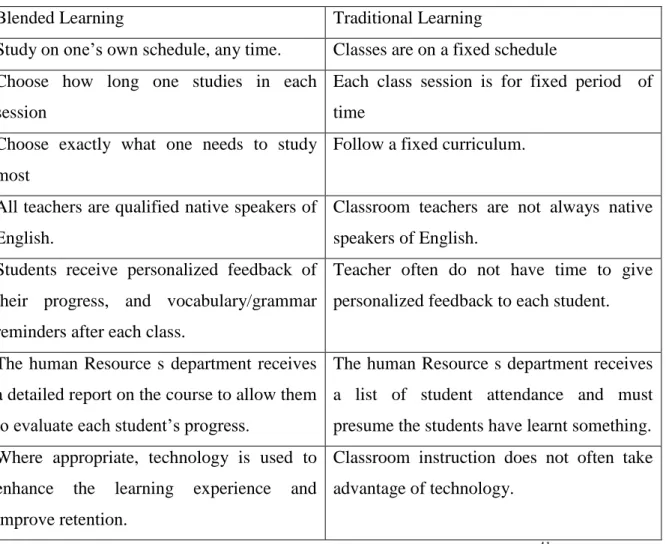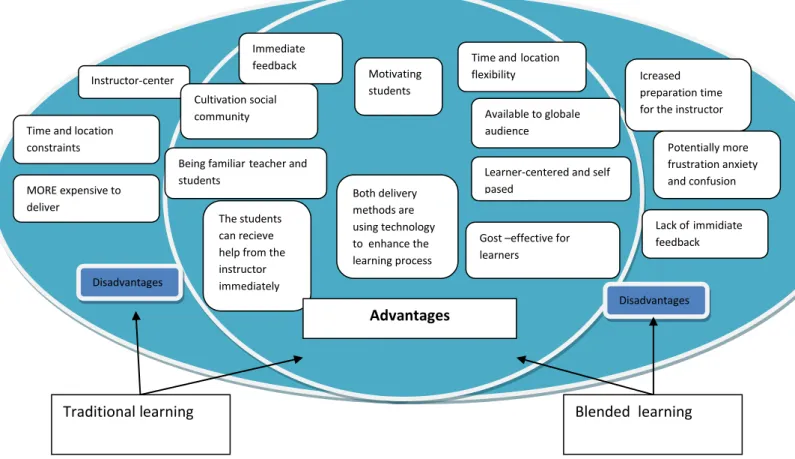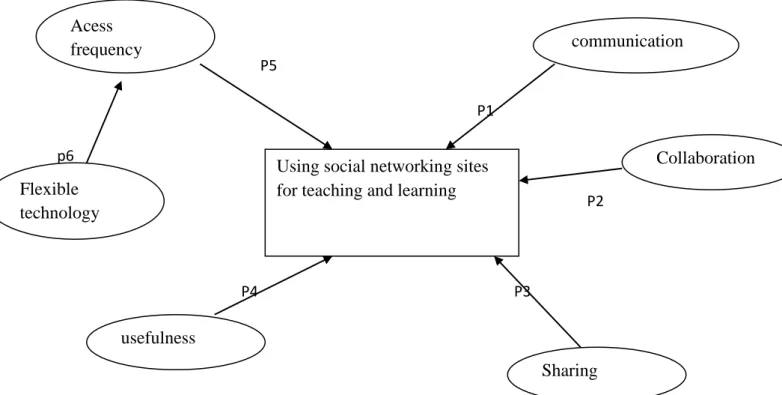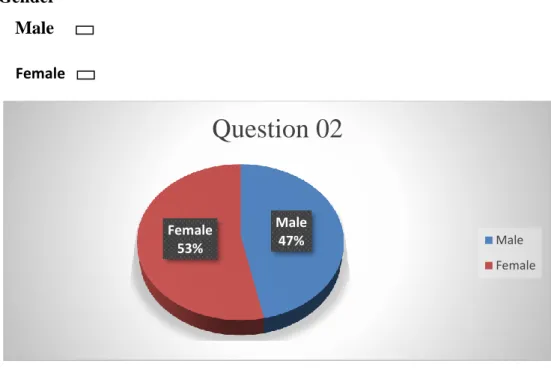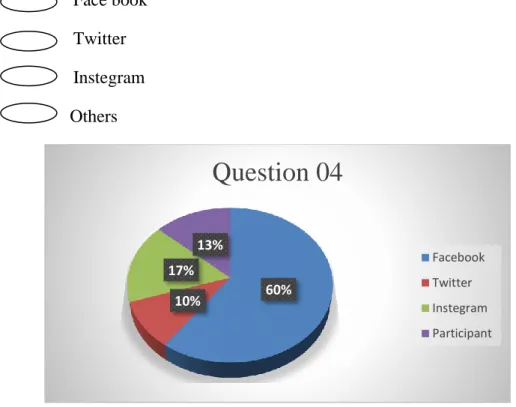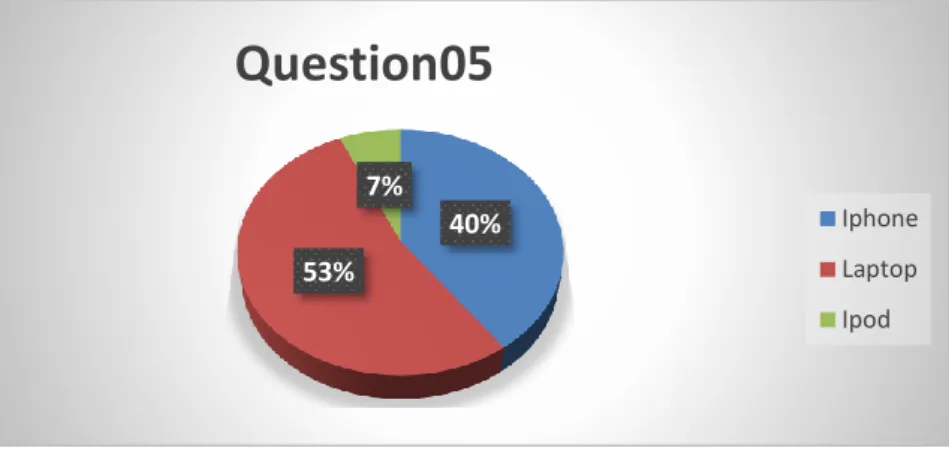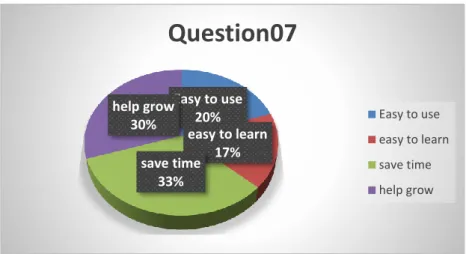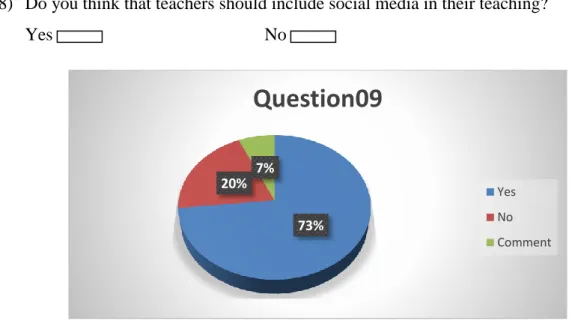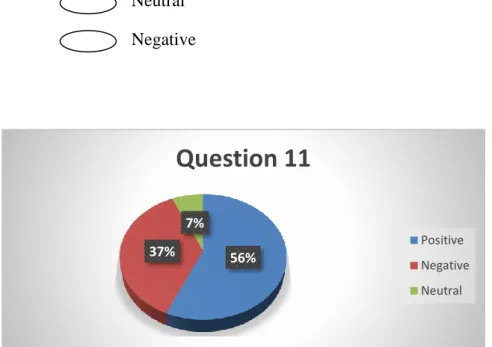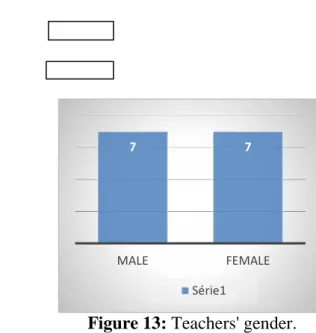I Abdel Hamid Ibn Badis University
-Mostaganem- Faculty of Letters and Arts
Department of English
Dissertation Submitted to the Department of English in Partial Fulfillment of the requirements for the degree of
Maser (LMD)
Applied Linguistics and ICT’s Supervisor: Dr. Sarnou Dallal
Chairwomen:Dr. Sarnou Hanane Examiner: Miss.Kharoubi.Mounira
2016/2017
The Use of Social Networking Sites as an Educational Tool
Facebook, Twitter, Instagram Case of study: Master One Language and
III
Dedication
In the name of God, most merciful, most compassionate.
This work is dedicated to :
My dearest parents, who have always supported me and supplied with all the needed to achieve. All my family, particularly my husband « fathallah » for his supports, my little angels « Hadjer » and « Youcef »,to all my brothers and sisters. And to my friend and sister « souad » for her help during these two years.
IV
Acknowledgment
First and foremost, I hope that my supervisor Dr.Dallal Sarnou will find in this project a very modest expression of my appreciation for her supervision and constructive criticism. I would like to express my deepest gratitude to my teachers of Master2 « Applied
Linguistics ». My gratitude also goes to all the teachers of English department especially Mr.Moulai Hacen for his help in realizing this project.
I have to thank all those who believed in me and gave their moral to contribute in the achievement of this research.I would also express my thanks to the board of examiners Dr.Sarnou Hanane and Mrs.Kharoubi.
V
List of Tables
Table 01 : Learning online compared to Traditional learning……….…………..12
VI
List of Figures
Figure 1:Advantages and disadvantages of the Traditional Learning versus E-Learning. ... 13
Figure 2:Model of the SNSs potential uses for learning and Teaching. ... 17
Figure 3:Students' Gender. ... 29
Figure 4:Familiarity with SNS. ... 29
Figure 5: The most used sites ... 30
Figure 6:Means to access SNS. ... 31
Figure 7: The most popular SNS for Students. ... 31
Figure 8: The purpose of using SNS. ... 32
Figure 9: Daily use of SNS. ... 32
Figure 10: The inegration of social networking sites in education. ... 33
Figure 11:The Best way for learning. ... 33
Figure 12: Attitude towards the inegration of social sites in high education. ... 34
Figure 13: Teachers' gender. ... 35
Figure 14: Length of Teachers' experience. ... 35
Figure 15:The use of socail networking sites. ... 36
Figure 16: The most used sites. ... 36
Figure 17: SNSs as a reliable tool for Teaching. ... 36
Figure 18: Teachers' attitudes toward the use of SNS in high education. ... 37
VII platforms. Nowadays, social networking sites as twitter ,instagram and facebook have been world-widely known for playing important roles in education. Today the online learning is contributing to foster knowledge. Therefore, this research project aims at investigating attitudes and perceptions toward the use of social networking sites as an educational tool.Facebook, Twitter and Instagram were taken as a sample in this research. The study revealed that both of teachers and students in high education tend to shift their learning style to the digital one by using different kinds of social networking sites. After collecting the data of this study,the results showed positive attitudes toward the use of SNS as an enhancing tool in education which enables its users to interact,communicate and exchange information through this service.
VIII Acknowledgment ... IV List of Tables ... V List of Figures ... VI Abstract ... VII Table of content ... VIII
General Introduction ... 1
Chapter One: Historical Background
1 Introduction ... 31.1 Traditional Learning ... 3
1.1.1 The Impact of Traditional Learning ... 3
1.2 E-learning ... 4
1.2.1 Advantages and disadvantages of E-learning... 5
1.2.2 Advantages ... 5
1.2.3 Disadvantages... 5
1.2.4 Modalities of e-learning ... 6
1.2.5 Current Issues in E-Learning ... 7
1.3 Blended Learning ... 7
1.3.1 Benefits of Blended Learning ... 8
1.3.2 Challenges of Blended Learning ... 9
1.3.3 Strategies of blended learning ... 9
1.3.4 Impacts of Blended Learning in Higher Education ... 10
1.3.5 The Role of the Teacher in Blended Learning ... 10
1.3.6 The Role of the Student in Blended Learning... 11
Conclusion ... 14
Chapter Two: Theoretical background
2 Introduction ... 152.1 Definition of social networking sites ... 15
2.2 Social Learning ... 16
2.2.1 Blogs ... 19
2.2.2 Wikis ... 19
IX
2.2.6 Instagram... 20
2.2.7 Twitter ... 21
2.2.8 Facebook ... 21
2.3 Instagram as an Educational Tool ... 23
2.4 Twitter as an Educational Tool ... 23
2.5 Facebook as an Educational Tool ... 24
2.6 The Impact of Social Networking Sites ... 25
2.6.1 Advantages ... 25
2.6.2 Disadvantages... 25
Conclusion... 25
Chapter Three: Data Collection and Analysis
3 Introduction ... 273.1 Data Analysis ... 27
3.2 Questionnaires ... 27
3.2.1 Students’ Questionnaire ... 27
3.2.2 Description of students’Questionnaire ... 28
3.2.3 Teachers’ Questionnaire Analysis ... 34
4 Discussion of the Findings ... 37
Conclusion... 38
General Conclusion ... 38
Refrences ... Erreur ! Signet non défini. Appendix ... 40
1
General Introduction
The emergence of internet and networked computers has embedded our every day life. This new form of communication is enabled by the internet in general and social media services in particular. A new digital form of communication is seen as a new type of discourse,a new type of language Learning and teaching have witnessed a tremendous change over the last decades in light of emerging technologies with specific reference to the internet. Social networking sites as being part of the term « ICT » have highly contributed to the change of education especially higher education.
The term of social networking sites (SNSs) is distinguished by particular language used in networked environment. Nowadays, many social networking sites can promote the way people communicate, interact, collaborate, work and even learn.
Due to the integration of social networking sites in education,the present study is set out to find out:
Which kind of social networks do the students consider as a pedagogical tool in their learning ?
What is the most popular social network in higher education ?
The hypothesis related to this study suggests that
Social networking sites can effectively supplement teaching and learning
Students have positive attitudes towards the use of different kinds of social networking sites(Facebook, Instagram and Twitter) in their learning
Teachers of high education also prefer the use of social networking sites in their teaching.
Our research is divided into three chapters : chapter one and two are devoted to the theoretical framework: a brief theoretical overview and definitions of key concepts. Chapter three is practical; it includes data collection and analysis. The first chapter aims at introducing the field of research :e-learning in general, its definition, advantages and disadvantages and its relationship to other terms such as blended learning. The second chapter focuses on social networking, its definition, providing a description about the characteristics of its types. The last chapter explains the procedure that is used to collect and analyze the data . In this chapter, we introduce our research tools including the
2 questionnaires for both teachers and students. We also present discussion about the results obtained.
3
1 Introduction
The teaching and learning community has been tremendously influenced by information and communication technology (ICT) integration. The latter makes teachers/students modernized in the way they teach/learn in the side of education. The integration of ICTs is gaining more ground and reaching more educational institutions. This chapter provides a brief definition of the term traditional learning, followed by a consistent analysis of e-learning or electronic learning, and the different types which garner synchronicity and asynchronicity e-learning. Also, it defines online learning and other concepts which are related to blended learning. This chapter provides the reader with a comparison between traditional learning and blended learning
1.1 Traditional Learning
The term traditional learning means the earliest and ancient system which was developed on how to get education and how to impart education to other. The chalk and the talk method was used in the past .This instruction refers to teaching by traditional method (s). The traditional learning was defined as learning under the scope of classroom, viewed as teacher-centered and static.
1.1.1 The Impact of Traditional Learning
The learning is conducted with the whole class participating taking place within classroom and the school; there is almost no group or individual study. Furthermore, the teacher conducts the lesson according to the study of program and curriculum.1More particularly, the teacher in the traditional method usually talks more than the students. He/she conducts the lesson according to the study of the program and curriculum repetition. Hence, the students are not involved in inquiring-based education and in solving problems. Therefore, the student’s motivation is low and the subject matter is distant from them because they learn the “what” and not the “how”.2In other words, traditional classroom is conducted in a synchronous environment; it means that the students must be in the same place at the same time in order to learn. The traditional classroom has the major advantage of face to face interaction between students and their teacher as well as
1 Wanwipa. comparison of e-learning and traditional learning/international conference on mobile learning
P69
4 between students themselves.3The traditional way of teaching is concerned with the teacher being the monitor and the source of knowledge and the students play the role of receiving the information in passive way.
1.2 E-learning
The term electronic learning, also called e-learning, is used to refer to computer enhanced learning. E-learning includes all types of technology enhanced learning, where technology is used to support the learning process .E-learning is the use of technology to enable people to learn anytime and anywhere. “E-learning is a computer based
educational tool or system that enables you to learn anywhere and at anytime.”(Epignsosis,2014,p.5); e-learning allows individuals, especially learners, to learn at their own pace whenever they are in the world. In the 1880’sIssac pitman, who was a competent teacher in the domain, was sent assignment by mail and he would send his students more work to be done using the same system.4 In 1970’s e-learning grew in popularity and the open university in Great-Britain was keen to use e-learning; they had always focused on delivering knowledge from a distance. They used to afford course materials by posts and mails. By 1990’s, schools across the world started to adopt the new trend of e-learning, thinking about bringing education to 5people, who due to some time and geographical constraints, are not able to attend their pedagogical seats. In this regard, e-learning involves the use of a computer or an electronic device in some way to provide training, educational or learning materials.6 Another definition of E-learning is commonly referred to as the international use of network information and communication technology in teaching and learning.7 E-learning implies the use of internet or wireless to deliver and reinforce the learning process 8 According to the Cambridge dictionaries online, e-learning means to learn by studying at home using computers and courses provided on the internet.9 In 2001, Mark Rosenberg suggested the following definition of e-learning: “the use of internet technologies to deliver a broad array of solutions that enhance knowledge and
3 Journal of business administration online spring2002(a comparison of traditional,online and hybird methods
of course delivery)
4ssac pitman was an english teacher who was famous for developing a widely used sysrtem of shorthand in
1837, also known as pitman shorthand
5
6 Derek stockley2003
7 Som Naidu(2003) commenwealth of learning.a guid of principles,procedures and practices/ e-learning. pdf
5 performance.” (p28) 10 By the same token, Som Naido pretends that, if the letter “e” in e-learning stands for the word “electronic”, so e-e-learning would incorporate all educational activities that are carried out by individuals or groups working online or offline.11 In addition to that, Maltz et al suggests that e-learning is applied in different perspectives, including distributed learning, online, distance learning as well hybrid learning.(2005).12 In this context, Welsh et al (2003) presented the term as the use of computer network technology, principally through internet to provide information and instructions to individuals.13
1.2.1 Advantages and disadvantages of E-learning
Electronic learning has many benefits but also some drawbacks since it depends on
the needs and capacities .Sometimes e-learning is very useful, but on another hand it is less beneficial. So it is important to know the advantages and disadvantages of e-learning in order to know if it is enough for effective teaching/e-learning process1.2.2 Advantages
There are several advantages of electronic learning. First , the develop of an online brand, making professional connections. Then,the engagement with wider audience, listening, producing and sharing.Moreover, the student is an active partner in the learning process. In addition, It offers flexibility and learn at one’s own pace. Furthermore, successfully completing online courses build self confidence and encourage students to take the responsibility for their own learning.14 According to Mark Resenberg(2000)e-learning focuses on the need of individual learners as an important factor in the process of education rather than on the learner centered.15 Therefore, e-learning enhances the efficacy of knowledge and it is able to provide opportunities for relation between learners by the use of discussion forums.16
1.2.3 Disadvantages
E-Learning also has some negative aspects. According to Gary James e-learning limited formatting of content in current browsers, the net might not be the delivery
10 Mark resenberg(2001) strategies for delivering knowledge in the digital agep28
11 Som Naidu(2003) commenwealth of learning.a guid of principles,procedures and practices p2 12 Maltz et al(2005) ibid
13 Welsh et,wanberg CR,Brown EG, Simmiring MJ(2003)e-learning international journal of training and
development(7)245-258ibid.
14 Gary James advantages and disadvantages of online learning.
15 Mark Rosenbeg(2001)strategies of delivering knowledge in the digital age.p28
16 Is E-learning the right choice?(n.d)Retrieved from
6 medium. Further, the internet provides good means to get all kinds of information ,but makes it harder to assess some types of students feedback and information. Another negative aspect is the slowness of internet connections. Because electronic communication does not necessarily provide a good match for face to face communication and it is more linear then face to face discussion; instructors may not always be available, lack of quality assessment and feedback which may hinder learning.
1.2.4 Modalities of e-learning
In the virtual community of learning, two types of learning occur: synchronous and asynchronous e-learning. Both methods are distinct and wok depending on the participant’s way of dealing with information.
1.2.4.1 Synchronous E-learning
Som Naidu defined group based e-learning synchronously as a situation where groups of learners are working together in real time via an internet or the internet. It may include text-based conferencing, and one or two-way audio and video conferencing .Examples of this include learners engaged in a real-time chat or an audio-video conferencing.17On the other hand, synchronous learning requires time and sometimes place regularity from the participants, due to the need to be near appropriate transmitting and reception equipment. A Synchronous type according to Algahtani(2011) allows learners to discuss with the instructors and among themselves via internet at the same time with the use of tools such as the video conference and chat rooms.18Another notion to this mode is any learning tool that is in real life such as messaging that allows students and teachers to ask and answer questions immediately .Rather than learning on their own , students who participate in synchronous learning courses are able to interact with other students and their teachers during the lesson. He suggests that the main benefit of synchronous learning is to enable students to avoid feeling isolated since they are in communication with others through the learning process. Robert and Dennis (2005) pinpoint that “synchronous
communication enables monitoring the receiver’s reaction to a message, which makes the receiver more committed and motivated to read and answer the message.”(p.53)19
1.2.4.2 Asynchronously E-learning
On the other hand, asynchronous e-learning can be carried out even when both of teachers and learners are being offline. Thus, this method of learning is regarded as flexible
17 Som NaiduE-Learning AGuide book of principles,procedures and practices Common wealth of learning 18 International journal of education and research12 decembre2014
7 to the eye of participants since they can log on to an online course whenever they want and take time to provide thoughtful reflections. According to Som Naidu group-based e-learning asynchronously refers to situations where groups of learners are working over an internet or the internet where exchange among participants occur with time delay(i.e ,not in real time).typical examples of this kind of activity include on-line discussions via electronic mailing lists and text-based conferencing within learning managements system.20Therefore, Algahtani described the asynchronous as mode that also allows learners to discuss with instructors or teachers as well as among themselves over the internet at different times.21In this context, perfect examples about the term asynchronously are course work and communication delivered via web, email and messages posted on community forums. A student in asynchronous learning is able to follow the curriculum at their own pace without having to worry about scheduling conflicts.22
1.2.5 Current Issues in E-Learning
There is number of issues in e-learning environments that need to be considered these include interaction, cooperation and community which play an important role to support learning. New forms, new techniques, the development of system and personalization techniques that meet user personal needs, and current activity.(1) Moreover, delineating the aims and objectives of the course. Then, articulating a set of beliefs about learning and the way in which the team believe that students learn best outlining. And considering how learning will be evaluated. This includes linking assessment to both course and program aims and objectives and ensuring variety and relevance of assessment across the program and in context of student’s capabilities.23
1.3 Blended Learning
According to Cambridge dictionary blended learning refers to a mixing of different learning environments. Blended learning gives learners and teachers potential environment to learn and teach more effectively.24 In his book ALEX HERNANDEZ blended
20 Som naidu AGuid book of principles, procedures and practices 21 International journal of education and research12 decembre2014 22 Efront learning.net/talentlcomms.
23E-learning issues of pedagogy and practice for the information age2008chapter6 p.99
24 Cambridge university press blended learning creating learning opportunities for language learners Debra
8 instruction combines the best of empowering technology and human touch so we can help each students learn more than ever before.25Another definition to blended learning suggests that it is formal education program in which students learn in part through the online delivery of context and instruction.26Furthermore, Rovai and Jordan(2004) claim that blended learning is a mixture of online learning and classroom that contain some of facilities of online courses with the presence of face to face communication.27 In addition to that, blended learning means the combination of a wide range of learning media(instructor lead, web based courseware simulations, job aids , webinars, documents)into a total training program.28. However, Bonk(2004) pretends three most common definitions of blended learning. Firstly, blended learning as a combination of instructional modalities and delivery media .Secondly, as combination of instructional methods. Finally, blended learning is defined as a combination of online and face to face instruction.29
Thus, Osguthorpe and Graham(2003) suggested that the purpose of blended learning is to establish balance between face to face learning and online learning. A balance that varies from one course to another.30
1.3.1 Benefits of Blended Learning
Blended environment is the most effective mode in the teaching and learning process, since it combines the benefits of both traditional and online learning. Use of new technology and online resources not only can make learning materials more widely available to students. Online learning can provide students with more options regarding subject matter. Additionally, online learning can encourage students to reflect and think about how they learn.31 Another benefit of blended learning is that students have access to content at anytime and anyplace. Moreover, they take more control their own learning and they become more informed, more resourceful and constructed their own learning. Furthermore, blended learning enables students work to expand beyond the classroom boundaries. Therefore, students’ became better connected to their learning environment both in-school and beyond the school . In this case, Yuen(2010) believes that online
25 ALEX Hernandez ,partner at the charterschool grouth fund pdf 26 Blended learning implementation guid :john baily pdf
27 Rovai A.P & Jordan H.P(2004). « Blended learning and sense of community :acomparative analysis with
traditional and fully graduate courses »
28 Bersin&Associates,2003,as cited in Graham, Allen& Ure,2003,instructional modalities. 29 Bonk.C.J(2004) Blended learning :Recent Trends in ICT in education,P.78
30 Osguthorpe R.T and Graham.C.R(2003)Blended learning envirenments :Difinitions and Directions 31 Benifits and challenges of blended learning PDF http// :courses.edx.org
9 learning engagement may facilitate cooperative activities even beyond the classroom and provide an interactive setting for communication among students and teachers in the classroom.32
1.3.2 Challenges of Blended Learning
According to a study made by Northen Illinois University,blended learning has some specific challenges that have been highlighted in this research. For Northen University cannot take an existing course and just put it. For the Northen Illinois University, teachers and students must be given time to adapt and discuss with students the purpose of using technologies in the course can help them to adapt more quickly as well. Additionally, the teacher’s role will shift from being a presenter of information to a facilitator of knowledge33. Thus, Dalhstrom, Walker and Dziuban (2013) found that while students expect technology to be used in the classroom, they still want the teacher to provide some guidance for its use. Therefore, deciding which elements of a blended learning model requires in-person interaction and which ones are best mediated by technology is a complex decision (Alderich2006). 34
1.3.3 Strategies of blended learning
There are many strategies that can be used to support a blended classroom environment as getting students engaged because capturing students’ attention at the start of the course has the biggest impact. Maintaining engagement through the course requires the following six strategies: clear content, unambiguous instructions and guides, challenging tasks, authentic tasks, timely feedback and elaborated feedback. Finally, re-engaging students who drift away or fail to engage. The blended learning provides instructors and learners with a comprehensive learning model. They may experience the excitement of physical classroom formats such as lectures, books, labs, handouts and the integration of telecommunication technologies; computer, Internet, World Wide Web and mobile phone in their teaching and learning processes.35Tesilios, Daskalakis and Dapadoupou (2011) in
32Yuen,A.H.K.(2010) « Blended learning in higher education :An Exploration of teaching
Approaches ».proceding of the 18th International Conference on Computers in Education.
33 Northen Illois University,faculty development and instructional design center.http// :facdev.nivu.edu 34 Benifits and challenges of blended learning edx learning series :Blendedx.2015
35 Strategies for engaging learners in ablended envirenment /massy university
10 their study show that both simplicity of use and perceived usefulness have positive effect on student s’ attitudes toward using blended learning.36
1.3.4 Impacts of Blended Learning in Higher Education
Blended learning creates the synergy that fosters a climate for a positive realignment of higher education. Some researchers come in result that blended learning in higher education is an evolving phenomenon that offers promise for addressing challenges such as access, cost, efficiency and timely degree completion. And because instructors report that teaching in blended format is more time intensive than in face-to-face classes especially in the conversation phase, institutions.37 As claimed by perseira (2010) blended learning offers a more successful learning experience compared to the virtual learning environment.38 Blended learning affects higher education in positive way by forming the under pinning of the transformational model that irrevocably alters expectation for students, faculty and administrators.
1.3.5 The Role of theTeacher in Blended Learning
Blended learning is considered as a challenge to the teacher due to the modification in responsibility and a sense of danger that he/she may get stuck in the role of just giving technical advice. Teachers are interested in using blended learning to improve their professional profile. Moreover, teachers in blended learning want to achieve learning benefits facilitated by information communication technology (ICT). First of all, blended teacher should understand the technology students will be using in order to monitor students’ progress. Then, the teacher tries to create a data-driven culture to help his/her students inorder them disparate student’s data into actionable information. Indeed, the teacher in blended learning should make learning relevant engage his/her students and help them in any problem that may have in their learning .In addition, blended teacher must encourage online discussion because online discussion offers participants the opportunity to reflect on their classmates. In this light,EYHAB AND AL-RAHMAN(2013)suggests that
36 Tselios,N,Daskalakis,S,&Papadopoulou,M,(2011). « Assessing the acceptenece of blended learning
university course »
37 Educause.edu(center for applied research)2004 P10/11 blended learning
38 Pereira,I,(2010) « what will users expect from virtual learning method ?-a conceptual model to analyse
11 Technology renders it easy for learners to properl
manage their learning Time by adhering to assignment deadlines, contacting their instructors
Online for quires and academic consultations with no time restrictions And immediate updates regarding learning and assessment
activities(p-103)39
1.3.6 The Role of theStudent in Blended Learning
Blended learning offers students a complete flexibility to choose the time they study with no constrains of fixed classroom hours; this means that students have to work independently, taking responsibility of their own learning. At the same time, blended learning provides students with tools and opportunities to interact with their classmates and learn to take full advantage of the online community. On another hand, blended learning helps students to monitor their own progress and identify their own strengths and weakness.40
The pedagogical rationale behind blended language learning is the desire to allow for higher degree of learner independence in the teaching and learning of second/foreign languages.” (Strack 2007b,i)
39 Al-zumor,A-W.Q Al Refaai,I-K Eyhab A –E&Al-rahman(2013)EFL students’preceptions of a blended
learning :advantages limitations and suggestions for improvement English Language Teaching6(10)
40 Blended learning « creating learning apportunities for language learning »DEBRA MARSH « Cambridge
12
Blended Learning Traditional Learning
Study on one’s own schedule, any time. Classes are on a fixed schedule Choose how long one studies in each
session
Each class session is for fixed period of time
Choose exactly what one needs to study most
Follow a fixed curriculum.
All teachers are qualified native speakers of English.
Classroom teachers are not always native speakers of English.
Students receive personalized feedback of their progress, and vocabulary/grammar reminders after each class.
Teacher often do not have time to give personalized feedback to each student.
The human Resource s department receives a detailed report on the course to allow them to evaluate each student’s progress.
The human Resource s department receives a list of student attendance and must presume the students have learnt something. Where appropriate, technology is used to
enhance the learning experience and improve retention.
Classroom instruction does not often take advantage of technology.
Table 01: Learning online compared to Traditional learning41
The table above provides a brief comparison between the traditional learning and blended learning. In the traditional learning setting, students are one main important element, but they are just listeners and followers. The teacher, in this context, is the one who starts with actions and interactions. On another hand, the use of technology is considered as beneficial for both teachers and learners. Negroponte, Resnick,and Cassel(1997)argue that:
Digital technology can enable students to
became more active and independent learners.The internet will allow new knowledge building communities in which children and adults from around the globe can collaborate and learn from each other. Computers will allow students to take change of their own learning through direct
41Wanwipa. comparison of e-learning and traditional learning/international conference on mobile learning
13 exploration expression and experience.this shifts
the student’s role from «being taught” to learning and teacher’s role from “expert” to collaborator or guide (01)42
According to many authors it is important to realize that there are advantages and disadvantages with regards to traditional versus e-learning in delivering learning process. In Figure 1, some of these advantages and disadvantages are given:
Figure 1:Advantages and disadvantages of the Traditional Learning versus E-Learning.43
The figure above shows the pros and cons of the both types of learning i.e. the traditional and blended learning. On the whole, traditional learning is expensive, takes a long time and the result can vary. Blended learning offers an alternative that is faster, cheaper and relatively buy potentially better. Additionally, blended learning allows the learners to interact with content in an engaging and stimulating way. Therefore, the blended
42 Negroponte,N ,Renick,M,&Cassell,J.(1997).Creating a learning revolution.Available :
http://education.unesco.org/unesco/educprog/lwf/doc/portfolio8.htm
43 Learning styles and e-learning face to face to the traditional learning NINA BENCHEVA2010 p66
Immediate feedback
Icreased preparation time for the instructor time for the instructor Time andlocation
flexibility Motivating students Instructor-center Available to globale audience Cultivation social community Potentially more frustration anxiety and confusion Learner-centered and self
pased Being familiarteacher and
students Time and location
constraints Both delivery methods are using technology to enhance the learning process The students can recieve help from the instructor immediately MORE expensive to deliver Lack ofimmidiate feedback Gost –effective for
learners
Disadvantages Disadvantages
Advantages
14 environment is the most effective mode in the teaching and learning process. Thus, in traditional approach, most classtime is spent with the teacher lecturing and students watching and listening.
Conclusion
This chapter has shed light on the fundamental basics and key concepts related to the integration of ICT in the educational setting. We started referring to the different kinds of learning, its definitions, the benefits and the drawbacks and its influence on the learner. In this chapter, we have highlighted both the traditional and blended learning methods by pointing out the main differences between the two processes. Thus, more empirical research about the different kinds of social networking sites that can be used as educational tool will be required in the next chapter.
15
2 Introduction
This chapter is built upon the existing body of documented literature related to social networking sites. We first being with definition of the term social network. Following this, we present the potential of social networking sites with a focus on the different kinds of social networking sites that can be used as platform for educational learning. Then we move to the impact of social networking sites in education where we explain the benefits and drawbacks of this service in the education.
2.1 Definition of social networking sites
One of the main elements in reaching learning objectives is to engage the students in course content. By the integration of the different kinds of social networking, the students have the opportunity to provide themselves with the content the way to they want to learn.
The term social networks sites was defined by Boyed(2003)as software products developed to make mutual interaction between individuals and groups.44 Social networking sites can be broadly defined as website that bring people together by sharing news,photographs,videos and events.45 Social networking systems allow users to describe themselves and their interests,connect communicate with others and set up groups on dedicated topics.In addition Boyed and Ellison(2008)set up a number of benefits of social networks sites; they consider social network sites as web-based services that allow individuals to construct a public or semi-public profile with bounded system. Secondly,social network sites articulate a list of other users with whom they share a connection. Finally, it views and traverses their list of connections and those made by others with system.46 Boyed and Ellison(2007)define social networking by key technological and social properties:
Social networking sites as web-based services that allow individuals to(1)construct a public or semi – public profile within a bounded system, (2) articulate a list of other users with whom they share connection,
44 Boyed D.M&Ellison W.B(2007)social networks sites definition,history and scholarship.journal of
computer-mediated communication,13(1),article 11 retrieved(15jan,2016)from http://jemc.indiana.edu/vol113/issue/boyed.ellison.com
45 OECD ,2007cachia2008 46ibid
16 and (3) view and traverse their list of connections and
those made by others within the system(p.2011)
Social networks sites enable its users to connect with friends and colleagues,send mails, messages, blog, meet new people and post personal information profiles which may comprise blogs , photos,videos,images and audio content. Social networking sites have an impact on people as well.It enables them to socialize, exchange information and ideas,share interests, etc. Facebook, Twitter, instagram, youtube, and other social media sites allow people to have a life in a virtual word and share it with others regardless time and place ;Bibaš (2001) notes,
it enables diverse forms of communication : from mass communication via the world wide web, group discussions in Internet chat forums, to person-to-person communication by e-mail.
2.2 Social Learning
According to Leach (2013) social learning uses the power of education. Social learning is a method of using mobile devices to enable students to learn through the use of technology, and the top three social networking sites with active users are facebook,Twitter and Instagram. Social networking sites for educational objectives seem to be praised due to their capacity to engage students in communicative practice and collaboration. In this regrads, Lee and McLoughlin(2008) suggested that social networking sites as educational tool because students use them for communication and social support at the same time for discovering and sharing knowledge.In this case, we can consider emerging research from different universities that the application of social networking sites is seen to have the potential to enhance learning and teaching .In this context, a study conducted in Sultan Qaboos University, Oman(2014)proposed that the majority of the students believe that the best way for teaching is the online learning by using different social networking tools. Moreover, it was determined that the majority of students do not prefer the traditional style(53%),although a few(17%)feel that they can meet their educational needs by relying on this style.47
17 Figure 2:Model of the SNSs potential uses for learning and Teaching.48
P5
P1 p6
P2
P4 P3
The utilization of social networking sites in education has shown to benefit education in different ways. The probable benefits of SNS for a tertiary level instruction include: improving teacher-student communication in the out of the population context, prompt feedback from teachers and also students, assistance in socialization, building community, destroying barriers, online companion discourse and connections over coursework. Furthermore, Concerning illustration students' outcomes, time space autonomy Also capability should substitute course administration framework.
48 Adapted fromMazman& Ustuel,2010
Using social networking sites for teaching and learning Acess frequency Sharing usefulness Flexible technology Collaboration communication
18
LEARNING THEORY CITATION
Social learning theory
Social networks build social capital where students are supported by, and participate in, learning communities influenced by social discourse and symbolic interactions. Providing students with social, emotional, and cognitive support. Fulfilling various social learning functions through
collaboration and students like minded learners and building students
communication and technology skills and understanding different point of view.
Greenhow& and Robelia(2009) Smith(2009)
Brown(2008)
Ellison, Steinfield,& Lampe(2007) Buzzetto-More(2012)
Constructivism
Learning that is student-centered and self directed ,instructor-facilitated, experiential, active, authentic, reflective, and dependent on social discourse.
Cheal (2012)
Learning Available On Demand Learning
That can be available synchronous and asynchronous, via any location, and through the use of a number of electronic mobile and non-mobile devices.
Fogg et al. (2011);
United States Department of Education (2010)
Authentic Learning
Learning that is based on real world activities and activities that represent authentic applications.
United States Department of Education, (2010);
Yang Su, (2011); Fogg et al. (2011) Student-Centered Learning
that is student-directed and active and where theresponsibility is shifted to the student with the instructor serving asa facilitator
Fogg et al. (2011); Buzzetto-More (2012);
Student-Centered Learning Learning that is student-directed and active and where the responsibility is shifted to the student with the instructor serving asa facilitator
Greenhow as reported in Yang Su, (2011)
Student Engagement Learning
Where students are committed participants in the learning process, motivated to succeed, active in learning communities, and willing to persist despite challenges.
Shih(2011) Webb(2009)
19 Digital Literacy Learning
that supports the new literacy movement, which includes not just traditional print-based literacy but also computer basics, use of hardware and software, information acquisition and usage, ability to navigate and use the World Wide Web, Internet security and safety, communicating via social media, and awareness of cyber bullying and other predatory online behaviors.
Coiro et al(2008)
Media Richness and sensory complexity Learning that is media rich and has sensory complexity leads to high-disclosure and greater engagement on the part of learners
Cheal(2012) Jones&shiao(2011)
Table02: learning theories supported by Social Networking49
2.2.1 Blogs
The term blog refers to web-based log that was coined by Jorn Barger in 1997. It refers to a simple web page consisting of brief paragraphs of opinion ,information, personal diary entries or links,called posts. A large number of people engaged in blogging for many reasons.First, they are simple to set up,edit and publish. Furthermore, topics can be as formal or personal as appropriate by the writer. Most blogs also allow visitors to add a comment below a blog entry. In addition, the blog allows anyone to self publish online without prior editing. The great benefits of blogging is to offer an opportunity for students to become teachers by presenting materials to the audience.50
2.2.2 Wikis
A Wiki is a website that allows its users an easy creation and editing of any number of interlinked web pages. Wikis have been around since the mid-1990 when the first wiki wiki web was developed by Ward Cunningham.The most prominent example of a wiki is Wikipedia. Since its creation in 2001, wikipedia has grown rapidly into one of the largest reference websites, attracting at least 684 million visitors yearly by 2008. Moreover, there are many sites such as wiki spaces and wet paint that offer free wikis to educators. The
49 Interdisciplinary journal of information,knowledge and mangement volume7,2012 p69/ special section
networking,teaching and learning nabuzzetto-more@umes.edu
50Scott MC Leod& chris Lehmann « what school leaders need to know about digital techniques and social
20 benefits of wikis is that they can simplify the educators’ work by holding items together without requiring sophisticated programming knowledge.51
2.2.3 Podcasts and vodcats
Podcasts are audio or video files shared online. Podcasting allows listeners to conveniently keep up to data with recent audio or video content. One of the most important characteristics of podcasts is the ability to download content and take it on the go using a mobile device.Podcasting is becoming increasingly used in education(Britain and al.,2006; Recthamm and zhang,2006) and recently there have been moves to establish a UK HE podcasting community.
2.2.4 Linkedln
According to the Cambridge online dictionary, LinkedIn refers to a social networking website for business people to communicate, find new job opportunities and share information .It was launched on may 5,2003 and its purpose was to provide people with the possibility to use it for professional networking. One of the major features of LinkedIn is its groups, which enable anyone to begin a group based on an association or industry topic. Moreover, LinkedIn members can request an invitation to the group and receive posting by other members via e-mail.
2.2.5 You Tube
YouTube is video-sharing service that allows users to watch videos posted and upload their own videos .It has started as an independent website in 2005 and it was acquired by google in 2006.Visitors can view videotaped courses and events on YouTube .com without paying any charge .These videos cover millions of lectures from bioengineering to peace and conflict studies. More particularly, you tube offers a wealth of opportunities for learning, sharing and collaborating over developing education. In fact, many educational institutions such as Cambridge university and the university of Edinburgh recognize the value of you tube to communicate corporate and promotional messages to students.
2.2.6 Instagram
Instagram is mobile application that can be download on phones and tablets.Keep in that you can only share photos and videos from mobile application. The name instagram is a combination of « instant camera » and « telegram ».It was founded in 2010 by stanford graduates, kevin systom and Mike Krieger. They created an HTML5 check in project
21 called Burbn which was then re-developed to photo-sharing uploads.52 Hash tags are the most used as discussion forums. It is combination of characters,so it can become a hash tag.. Hashtag (#) are used on instagram for posting pictures and hash tagging it with its subject.53 Instagram is one of the most popular social networks in the world based around sharing pictures and videos which can be posted. The focus of instagam is for users to post individual images or videos with description on their profile. Therefore, instagram seems to provide an ideal environment for second language learners to produce descriptive writing.
2.2.7 Twitter
In 2006, social networking have been revolutionized by new website, twitter .This website will be characterized as micro blogging service, which permits users exchange information, known « tweets ». Tweets are text-based messages can be sent and received from computer or mobile that need aid 140characters (forgie et al2013).Twitter is outlined which offer users on need. Discussions, offer ideas and also offer its users with more extended articles and networking (forgie et al 2013)54. Twitter may be the major well-known micro blogging, which visited by millions of users called twitterers, who can send and receive messages through the web,sms,and by outsider provision. Twitter is a social networking service that enables its users to send and read other users’ messages called « tweets ». Twitter may be the majority well known micro blogging which offer on that millions of users called twitterers, who can send and receive messages through the web, sms, and by outsider provision. However, to get on Twitter it. First, you sign up an account. Then, choose username that will figure on all your tweets.
2.2.8 Facebook
Facebook is corporation and online website owned and operated by facebook.Inc. , and founded infebruary,4,2004 by Mark Zuckerberg and Chris Hughes at Havard University to provide the students of Havard University with place to keep in contact with their classmates and share study –related information. Yet, by the year of 2006,the website become open to anyone with an E-mail address. The website name is taken from the name of the book which is handed to students at the beginning of the university academic year in
52 Departement of computer science,arizona state university,Tempe AZ85281 53 http// : www.wiwm.edu/instagram sarah -juliano.PDF
22 order to help students know each other. In fact,as of august 2015,Facebook had over 1.59billion monthly active users and by january2016,the number of facebook mesengerusers increased to 800 million. Facebook constitutes a rich context for people to commminicate with their peers,friends or ever strangers,share common intersts
2.2.8.1 Face book group
Facebook constitutes a rich context for people to commminicate with their peers,friends or ever strangers,share common interestsand join fan group.Additionally, according to Bodomo(2010):
Facebook, the new CMC medium,would become one of the most popular websites and now attracts more than a100 million participants. Its popularity has inceased so much so that not only the youth but some prominent members of older generations such as businessmen and politicians,even use it to get in touch with customers,constituents and other target groups(p.316)55
Thus,facebook group has many functions that help its members to interact and discuss together and the posibility to add videos and images.And also,Facebook group is created to provide students with their own learning.
To sign in the facebook group, you need to log on to your facebook account .Then, click on « create group »which is on the left. After, you name the group and invite people you want through facebook friends ‘name or emails. Additionally, you select between « public » option which means any one can join the group or the second option « closed » which means that any one can see the group but only members can see posts. The function of facebook group is to help the members to socialize,collaborate and share ideas. Therefore, students and teachers can post or write topics in facebook group and open discussion between both students and teachers. (Gulbahar,Kalelioglu&Madran,2010. Hence, the text posted could be also information to students about the time table or something else about their field, so they will be informed without travelling and losing much time. In this
55 Bodomo,A.B(2010).Computer mediated communication for linguistics and literacy :Technology and
23 context, Shih(2011)pointed that by setting up a discussion group,students can use greater level of grammatical complexity in their writing so they can reduce their mistakes56.This feature is one of the most significant in the facebook group. In fact, students can practice their four micro skills (listening ,reading, speaking and writing)
2.3 Instagram as an Educational Tool
Instagram can be used as a tool to enhance students’ learning. Teachers can create board for specific classes by creating an instagram video to share. According to Laponsie(2013) students can create photo prompts to share and engage students in writing responses based upon the photos or by having essays based upon list of themes or concepts from curriculum of Instagram. Instagram gives the opportunity to students to connect and engage with course concepts.
2.4 Twitter as an Educational Tool
Twitter may serve both teachers and students to engage in the learning process. This tool can be used to have resources, promote brainstorming, share and discuss particular topics. However, teacher can use twitter to update class reading or news lists. Twitter also offers numerous chances for specialists. Ovadia(2009) supports that Twitter offers an incredible stage to planning also directing academic studies.57Twitter gives help students’issues,it develops students composing skills. Moreover, twitter offeres teachers the opportunity to create personal learning network. Twitter account allows the students to participate in conversations directly, and it provide them with an authentic global audience to share ideas, ask questions and get information. In study used by Kelly Tenkely’s(2010)illustrate that twitter can align with the level of bloom’s taxonomy for instance,(1)creating twitter profile,(2)Evaluating tweets and write about it,(3)Analyzing the use of twitter and compare it to other social media,(4)Applying the use of twitter to examine popular trends,(5)understanding poem or short story by tweeting the main idea,(6)Remembering content by rewriting tweets in your own words.58Twitter account, can help students to develop their writing skills when they express ideas on course content.
56 Shih,R-C(2011)Can web2.0technology assist college students in learning english writing ?Integrating
facebook and peer assessment with blended learning.
57 Twitter as a learning tool in the intermdiate classroom.http://novemberlearning.com
58 Systemics,cybernetics and informatics volume12 november6,2014 ISSN :1690-4524/integration of
24
2.5 Facebook asan Educational Tool
Facebook is the most popular social network among teachers and students. According to Munoz and Towner (2009)
facebook is network that connects students with
other students, indirectly creating a learning community-a vital component of student education 59.
Facebook helps the students to build their courses and at the sametime establish a sense of community among their peers. Facebook has become a part of students because they use it as a way of communicating. In addition to that, students can reach their academic goals through the use of facebook account. In facebook groups, students have the chance to exchange ideas and to share resources.Indeed,it may help them to engage with a particular topic. For Levinas, the word face has broader meaning which is not necessarily about physicality or proximity, but rather about much wider range of communicative acts.60According to facebook guide,( Fogg et al,2011)
Facebook can provide students with the opportunity to effectively present their ideas, lead online discussions, and collaborate. In addition, facebook can help you, as an educator, to tap into the digital learning styles of your students. For example, it can facilitate student-to-students collaboration and innovative ways for you to involve students in your subject matter. We also believe that facebook can be powerful tool to help you connect with your colleagues, share educational content, and enhance communication among teachers, parents and students.( p.3)61
59 Columbus state university prespective in learning volume14 november1,2013/facebook as learning tool. 60 Leaver,K&Kent,M(2014)introduction –facebook in education :Lessons learnt digital
culture&education,6 :60-65
61 Interdisciplinary journal of information,knowledge and mangement volume7,2012 p69/ special section
25
2.6 The Impact of Social Networking Sites
Social Networking Sites enable students to express themselves, communicate and gather profile that highlight their abilities and experiences. As social networking site has much benefits among learners; it can also has some drawbacks that negatively influence learning.
2.6.1 Advantages
Social networking sites have many advantages especially in education because they help to establish enduring relationships with real people. Social networking sites encourage students to interact with each other and share ideas. Therefore, social networking sites help in the development of creativity since users can upload pictures, videos or stories; this gives chance to students to improve their artistic abilities and provide them with much confidence. Indeed, its prompt feedback from both teachers and students, online peer discussions and interaction about coursework. In addition, social networking sites give the ability to substitute course management at the same time it is time-space independence. In addition, one of the features of social networking sites is the fast and direct communication. Via Social networking sites people can share interests and exchange it with other people around the world while at the same time keeping contact with family, friends and colleagues and building new friendships.
2.6.2 Disadvantages
As social Networking sites have benefits, they also have some drawbacks that we can find them especially in the educational context. Being connected and searching for information on facebook, google and other web sites can seize and fragment our attention. Some researchers suggested that the heavy use of internet with greater impulsivity,less patience,less tenacity, and weaker critical thinking (connolly,2011)62. Furthermore, the social networking sites can become an addiction as their users can become obsessed in finding their teachers on facebook and intrude in teachers’ private lives.
Conclusion
To conclude, this chapter has presented the main steps that make our research more accurate. In other words, this chapter revealed the importance of social networking sites in
62 Connolly,M.(2011)Benefits and drawbacks of social media in education.Retrieved from
26 the educational setting. To summarize, our chapter explored the use of social networking sites as an educational tool.
Social networking sites are used by teachers and students to enrich existing curricula. Likewise, social networking services have been shown to foster social learning through engaging students in communicative and creative literacy practices. In this study ,we take into consideration understanding the social networking sites,the diffrent kinds of social networking services and their impact on the educational system. Finally, we presented the pros and the cons of social networking sites on the academic achievement.
The following chapter outlines data analysis of both of questionnaires one for students and other for teachers in order to now their attitudes about the integration of social networking sites in education.
27
3 Introduction
This chapter deals with the practical part of the study.A detailed description of the means of data analysis,results and their analysis will be presented. Therefore,some implications and recommendations for EFL teachers are also to be included. In the following section, we shall first introduce our research methodology and the tools that were utilized to gather data.
3.1 Data Analysis
Data Analysis is considered as ambiguous and time –consuming,but also as a creative and fascinating process. In this context, Marshall and Rossman(1999,p150) describes data analysis as the process of bringing order, structure and meaning to the mass of collected data. Broadly speaking-while it does not proceed in linear fashion-it is the activity of making sense of ,interpreting and theorizing data that signifies a search for general statments among categories of data(Schwandt,2007 ;p.6).the chapter also reports the finding obtained from analyzing data before concluding with a detailed discussion and conclusion inorder to gain an in depth understanding about the integration of social networking sites in education.
The present study includes two survey questionnaires. The first one is designed for EFL master (1)students from the University of Mostaganem. This part, which is based on the results of the questionnaire,deals with a quantitative analysis of data. The second one is prepared to English teachers from the department of English at the same university who use different kinds of social networking sites when dealing with students. The second one, which is based on the results of teachers questionnaire, is a qualitative analysis
3.2 Questionnaires
The current questionnaires are used for the sake of eliciting data from master(1) students of English at University of Mostaganem as well as from teachers of the same University « Abdelhamid ben badis »Mostaganem.
3.2.1 Students’ Questionnaire
This questionnaire is addressed to the EFL students of Master 1 level of language and communication belonging to the University of “Abdel hamid ben badis” Mostaganem.
28 35 case were prepared, but in fact only 30 students answered the questionnaire and give it back.
3.2.2 Description of students’Questionnaire
The students’ questionnaire consists of eleven (11) questions of both multiple-choices and open-ended types. These questions are designed to elicit students’ comments about the use of social networking sites and which one is appropriate as an educational tool. After collecting several responses from students, we began to analyze the students’ perceptions and attitudes toward the use of social networking sites.
Part one
This part of questionnaire aims of gathering general information about the respondents. We started by their age and gender. Afterwards, we moved to ask them if they are interested in using social networking sites as an educational tool(1Q),to select which one is appropriate (2Q),and how they access to social network sites(3Q).
Part two
In this section, students were asked to think about the most popular social networking site in their opinion(6Q).Then, they were asked about the reasons behind using online sites in their learning(7Q). Another question is about the time they spend in using social networking sites (8Q). As for the next question, it was about the daily use of social networking sites. After that, a direct question was asked about the way of teaching they prefer: the traditional or the blended modern way (10Q).While the last question was about their attitude toward the use of social networking sites in higher education(11Q).
29 Section one :General information
1) Gender Male
Female
Figure 3:Students' Gender.
The figure above shows that (16) of the participants out of the chosen sample of the study are females whereas the remaining(14) are males.
Section2 :
2) Are you interested in using social network sites (SNS) as an educational tool?
Yes No
Figure 4:Familiarity with SNS.
Male 47% Female 53%
Question 02
Male Female 83% 17%Question 03
Yes No30 The figure above illustrates that (25)of the participants are interested in the use of social networking sites, and (5) of them are not familiar with social networking sites.
3) Which of the following social network sites (SNS) do you use? And why? Face book
Twitter Instegram Others
Figure 5: The most used sites
As it is shown in this figure above, the most used social networking site by the majority of participants is facebook with (18)respondents. However,(3)participants chose Twitter, and(4) participants said they use Instagram and (5)participants chose others.
4) How do you access to social networking sites? Smartphone Laptop IPod 60% 10% 17% 13%
Question 04
Facebook Twitter Instegram Participant31 Figure 6:Means to access SNS.
This figure shows that (16)of the students use their laptops to access in the social networking sites .While (12)of them use their mobiles and(2)of the students use Ipod.
5) In your opinion, which one is the most popular SNS for students?
Figure 7: The most popular SNS for Students.
Most of students(22) claim that facebook is the most popular of all SNSs while (3)students chose twitter and only (3) prefer Instagram.
6) Rate the reasons why you use online sites for learning They are easy to use
They are easy to learn
They can save time in sharing information
40% 53% 7%
Question05
Iphone Laptop Ipod Student 1 14%Student 2 10% Student 3 73% Student 4 3%Question06
Student 1 Student 2 Student 3 Student 432 They help me to grow my professional learning
Figure 8: The purpose of using SNS.
This figure illustrates that (10 students use SNS to save time. However,(6) of them use it because it is easy to use.While,(9)students agree that SNSs help them to grow their professional learning,and (5) students said that it is easy to learn.
7) How much time doyou spend daily in using SNS? 1 hour
2 hours 3 hours More
Figure 9: Daily use of SNS.
In this figure (18) of students use SNS for more than three hours a day whereas (5) of them use it for one hour and (3) of them use SNS for two hours and(4) spend three hours on SNSs. Easy to use 20% easy to learn 17% save time 33% help grow 30%
Question07
Easy to use easy to learn save time help grow 17% 10% 13% 60%Question08
1 hour 2 hours 3 hours More33 8) Do you think that teachers should include social media in their teaching?
Yes No
Figure 10: The inegration of social networking sites in education.
Here in this figure(19) students said that teachers should include social media in teaching while (6)of them said that it is not important to include social media in teaching. So we deduce that the majority of the users prefer the integration of social networks in education.
1) Do you prefer the traditional way of learning or learning through SNSs? The traditional way
The SNS way Both
Figure 11:The Best way for learning.
73% 20% 7%
